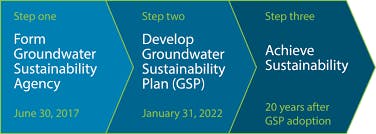Mission Statement
To protect water rights & conserve & augment the District's water supplies in an environmentally responsible manner for residential, agricultural and commercial uses.
Our Purpose
In 1939, the people of the Santa Ynez and Lompoc Valleys joined together to form this water conservation district. The purpose was to prevent the entirety of the upstream Santa Ynez River being diverted out of the watershed to a coastal stretch of populated and agricultural areas extending from El Capitan on the Gaviota Coast to the Ventura County line. Today, the Santa Ynez River Water Conservation District (SYRWCD) protects water rights and supplies within the Santa Ynez River watershed, manages releases of water from Bradbury Dam to replenish downstream aquifers along the river and on the Lompoc Plain, and monitors, reports, and manages groundwater conditions.
Groundwater charges levied by the SYRWCD are in furtherance of District activities in the protection and augmentation of the water supplies for users within the District or a zone or zones thereof which are necessary for the public health, welfare, and safety of the people of this state (Water Code Section 75521). Such activities include:
- Planning, scheduling, and managing the release of water from and downstream of the Cachuma Project Bradbury Dam for the satisfaction and benefit of downstream water rights, including the timing, volume, and rate of flows to promote recharge in the river alluvium and the Lompoc Plain, as provided in State Water Resources Control Board (SWRCB) Order No. WRO 2019-0148.
- Reporting on Santa Ynez River system conditions, basin surface water use, and water purchased by contract.
- Supporting compliance with agreement(s) and procedures to mitigate downstream flooding because of Cachuma Project storm operations.
- Contributing to the review, preparation, and compliance with applicable biological assessment and opinions, including associated consultations, revisions, and replacements, for the protection of endangered species in the Santa Ynez River, while assuring that downstream water rights and water quality in the basin and downstream of Bradbury Dam are maintained and protected.
- Recording groundwater production within the District.
- Monitoring and reporting on groundwater conditions within the District.
- Levying and collecting charges on groundwater production within the District.
- Making annual groundwater use estimates and forecasting groundwater storage and overdraft amounts within the District.
- Determining water volume for replenishment of the dewatered aquifer storage below Bradbury Dam.
- Participation in the three Groundwater Sustainability Agencies (GSA) covering the Santa Ynez River Valley groundwater basin and District. Such participation includes, but is not limited to, coordination, preparation, and implementation activities and provision of administrative support (including arranging GSA committee and citizen advisory group meetings, recordkeeping, and bookkeeping) associated with the GSAs’ Groundwater Sustainability Plans (GSP), annual reports, and associated implementation and other activities. This includes coordinating and contributing to responses to comments made on the GSPs and related technical studies. It also includes participation in discussions of long-term governance and funding for the GSAs.
- The District’s administrative support of the GSAs, which requires an expenditure of significant District staff time, has been necessary, in part, because the GSAs have not yet hired their own staff or legal, engineering, or other consultants, and have yet to levy any groundwater fees or charges on landowners or pumpers within the GSAs or otherwise create an independent funding source (aside from grant funding and certain contributions from parties to the Memoranda of Agreement [MOA], as defined below). While it is expected that the District will continue to incur costs to participate in the three GSAs and as the single point of contact with the California Department of Water Resources (DWR), the level of District administrative support could change in the future depending on the GSAs’ future governance structure, funding sources, and staffing and contracting decisions.
- The District’s activities as a party to all three GSAs benefits all pumpers within the District, which depend upon the District to provide local agency Sustainable Groundwater Management Act (SGMA) coverage within its approximately 180,000 acres within the basin. In the absence of such SGMA coverage by the District, the entire basin may not be covered and in such event would be subject to State Water Resources Control Board intervention and management of the basin as a probationary basin (Water Code Section 10735.2 (a)(4)(B)). The District’s SGMA activities benefit, among other pumpers in the District, the pumpers in Zones A, who pump from the river alluvium and benefit from the District’s investigation and efforts supporting the characterization of those zones as not groundwater subject to SGMA management in the GSPs, and the District’s anticipated need to defend that characterization against those who disagree with it and contend such pumping must be managed under SGMA. To date, DWR has not decided on the adequacy of the GSPs, which may include an evaluation of that characterization.
- Acting as the single point of contact between the GSAs and the DWR for SGMA compliance, for the benefit of all three GSAs.
- Administering SGMA grant funding for the benefit of all three GSAs.
- Participating in the Integrated Regional Water Management Plan process to promote regional water management strategies to ensure sustainable and reliable water supplies, including the protection of agriculture.





